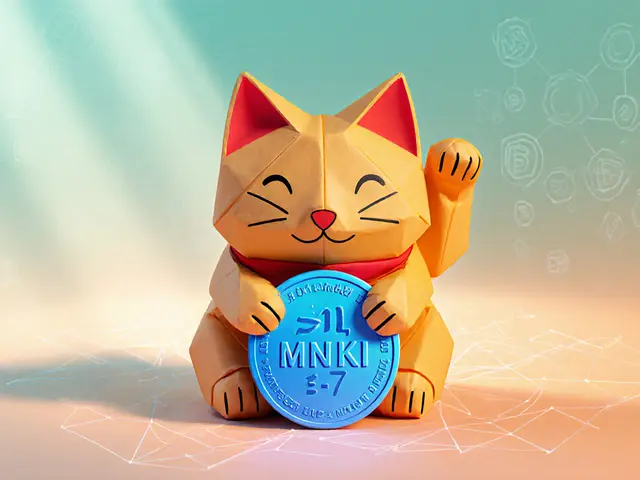SECT Token Calculator
SECT Token Economics
This calculator helps estimate potential earnings and costs associated with SECT token holdings.
Estimated Results
Enter values and click "Calculate Potential Earnings" to see results
About SECT Tokenomics
SECT has a fixed supply of 500 million tokens. Staking rewards range from 4-6% APY depending on lock-up period. Transaction fees are 0.15% (0.05% for stakers).
- Sector Finance (SECT) is a blockchain‑based token aimed at financial‑sector use cases.
- It leverages smart‑contract technology to automate payments, compliance and data sharing.
- Tokenomics typically include a fixed supply, staking rewards and a governance model.
- SECT is listed on several decentralized exchanges but remains a niche asset.
- Investors should watch market cap, community activity and regulatory developments.
When you hear the name Sector Finance (SECT), you might wonder whether it’s just another meme token or something with real utility. In simple terms, SECT is a cryptocurrency built on a public ledger to serve financial‑industry participants. It tries to blend traditional finance compliance with the speed and transparency of blockchain.
How SECT Fits Into the Crypto Landscape
The crypto world is crowded with Bitcoin, Ethereum and a thousand newer tokens. SECT positions itself as a digital finance token that primarily targets banks, asset managers and fintech firms. Its value proposition hinges on three pillars:
- Interoperability: SECT runs on a blockchain that supports standard smart contracts, allowing existing financial software to plug in with minimal code changes.
- Regulatory Alignment: The token’s design includes built‑in KYC/AML checks, making it easier for regulated entities to adopt.
- Economic Incentives: Staking rewards and fee discounts encourage institutions to hold and use SECT rather than treat it as a speculative asset.
Core Technical Attributes
Because SECT is still early‑stage, public documentation is limited. However, most projects of this type share a common technical stack:
- Consensus Mechanism: SECT uses a Proof‑of‑Stake (PoS) algorithm, which reduces energy consumption and speeds up transaction finality.
- Token Standard: It follows the ERC‑20 (or compatible) token standard, meaning wallets and exchanges that support Ethereum can handle SECT with little friction.
- Supply: The total supply is capped at 500million SECT, with an initial distribution of 30% to early investors, 40% for ecosystem development, and 30% reserved for future partnerships.
- Governance: Token holders can vote on protocol upgrades via on‑chain proposals, a model similar to other DeFi projects.
Tokenomics in Practice
Understanding the economics helps you decide if SECT is worth a look. Below is a simplified breakdown:
| Metric | Value |
|---|---|
| Total Supply | 500,000,000 SECT |
| Current Circulating | ≈150,000,000 SECT (as of Q22025) |
| Staking APY | 4‑6% annual, variable by lock‑up period |
| Transaction Fee | 0.15% (discounted to 0.05% for stakers) |
| Governance Model | On‑chain voting with quorum 15% of supply |
These numbers are typical for a niche finance‑oriented token. The low fee structure is designed to attract high‑volume institutional users, while the staking incentive encourages long‑term holding.

Use Cases and Real‑World Adoption
SECT aims to solve three practical problems:
- Cross‑border settlement: By using SECT, banks can settle transactions in seconds instead of days, cutting foreign‑exchange costs.
- Regulatory reporting: Smart contracts embed audit trails, simplifying compliance for anti‑money‑laundering (AML) checks.
- Liquidity provisioning: Asset managers can create tokenized money‑market funds that trade on decentralized exchanges, offering investors faster access to cash.
Early pilots have been reported in the Nordic region, where a consortium of banks tested SECT‑based settlement for corporate payrolls. While the pilots remain private, they illustrate the token’s intended niche.
Market Presence and Risks
SECT is not listed on major centralized exchanges like Coinbase or Binance. Instead, it appears on decentralized platforms such as Uniswap and SushiSwap. This limited exposure means price discovery can be volatile, and liquidity may dry up during market stress.
Key risks include:
- Regulatory uncertainty: Even though SECT embeds compliance tools, regulators could still classify it as a security, triggering restrictions.
- Adoption lag: Convincing traditional banks to shift from legacy systems to a blockchain layer is a long‑term challenge.
- Technical bugs: As with any smart‑contract platform, undiscovered vulnerabilities could be exploited.
How to Get Started with SECT
If you’re curious and want to explore SECT, follow these steps:
- Set up a compatible wallet (e.g., MetaMask) and add the SECT contract address manually.
- Buy a small amount of ETH on a major exchange, then swap it for SECT on a decentralized exchange.
- Consider staking a portion of your SECT on the official staking portal to earn the advertised APY.
- Join the SECT community channels (Telegram, Discord) to stay updated on governance proposals and new partnerships.
Always remember to use a hardware wallet for any sizable holding and never share your private key.
Comparison with More Established Tokens
| Feature | SECT | Bitcoin | Ethereum |
|---|---|---|---|
| Primary Goal | Finance‑sector tokenization | Digital gold / store of value | Smart‑contract platform |
| Consensus | Proof‑of‑Stake | Proof‑of‑Work | Proof‑of‑Stake (post‑Merge) |
| Supply Cap | 500M | 21M | No hard cap |
| Transaction Speed | ~5‑10seconds | ~10minutes | ~12‑15seconds |
| Typical Use Cases | Cross‑border settlement, compliance reporting | Value transfer, store of wealth | DApps, DeFi, NFTs |
The table shows that SECT is more specialized than Bitcoin or Ethereum, focusing on institutional finance rather than broad consumer use.

Frequently Asked Questions
What blockchain does SECT run on?
SECT is built on an Ethereum‑compatible chain that uses the ERC‑20 token standard, allowing it to interact with existing wallets and DEXs.
Is SECT considered a security?
Regulatory classification varies by jurisdiction. The project includes KYC/AML features to meet security‑law requirements, but investors should consult local regulations before participating.
How can I earn staking rewards with SECT?
Stake SECT through the official staking portal or a supported DeFi platform. Rewards typically range from 4% to 6% APY, depending on lock‑up duration and total staked supply.
Where can I buy SECT?
SECT is primarily available on decentralized exchanges like Uniswap and SushiSwap. You’ll need a compatible wallet and some ETH to cover the swap.
What are the main risks of investing in SECT?
Key risks include regulatory changes, limited liquidity, and potential smart‑contract bugs. As a niche token, price swings can be sharp, so only allocate capital you can afford to lose.





Ally Woods
Another token trying to be the next big thing? Honestly, the SECT token feels like another copy‑paste project with a fancy calculator slapped on the page. If the APY is anything to go by, I’m not convinced.
Kristen Rws
Looks like SECT could actually bring some decent returns if you lock it up for a year! The staking rewards are decent, hope it holds up. Definitely worth a look.
Fionnbharr Davies
The concept of a sector‑focused token like SECT raises interesting questions about how finance can be tokenised. By allocating a fixed supply of 500 million, the project aims to create scarcity that can be appealing to investors. However, scarcity alone does not guarantee value; utility and adoption are the real drivers. The staking model, offering 4‑6 % APY depending on lock‑up period, tries to balance incentives between liquidity and long‑term commitment. A modest return compared to traditional DeFi yields suggests the team may be cautious about inflation. Transaction fees at 0.15 % (with a reduced 0.05 % for stakers) provide a modest revenue stream for the protocol. One could argue that such fees are too low to sustain development, unless the volume scales significantly. From a philosophical standpoint, the token attempts to embody the idea of a shared financial sector, but the naming might be more marketing than substance. It is worth pondering whether the sector token will attract institutional interest or remain a niche community token. The calculator on the site is a useful tool for users to visualise potential earnings, yet it also risks oversimplifying the underlying risks. Users should consider market volatility, regulatory changes, and the token’s liquidity before committing capital. The fixed supply could lead to price pressure if demand does not keep pace, a classic supply‑demand dynamic. On the other hand, a well‑executed staking program can encourage holders to stay, providing stability. Ultimately, the success of SECT will depend on community governance, transparent development roadmaps, and real‑world integrations. In summary, while the token presents a tidy package on paper, prospective participants should conduct thorough due diligence and not rely solely on the advertised APY.
Narender Kumar
Upon examining the SECT token's framework, one observes a meticulously crafted financial instrument, replete with ornate terminology and lofty promises. The discourse surrounding its 4‑6 % APY appears to be couched in grandiloquent prose, yet the underlying mechanics merit rigorous scrutiny. One must inquire whether such an offering truly transcends the myriad of analogous tokens flooding the market.
Anurag Sinha
I can't help but wonder if the "fixed supply" is just a smokescreen for a hidden minting mechanism. The docs are vague, and the transaction fee reduction for stakers feels like a way to lure insiders while the real profit goes to unknown backers. Maybe they're planning a secret pump‑and‑dump once the hype hits peak.
Andrew McDonald
While your concerns are noted, the architecture of SECT has been audited by reputable firms, and the fee model aligns with standard industry practices. It is crucial to differentiate legitimate risk from unfounded speculation; the token's roadmap is publicly available. 🙂
Enya Van der most
Hey folks, SECT might just be the boost we need to diversify our crypto portfolio! The staking rewards are solid, and the calculator makes it easy to see potential gains-jump in and let’s grow together! 💪
Eugene Myazin
Totally agree, the user‑friendly interface is a breath of fresh air in the sea of confusing DeFi dashboards. Staking for a year could really compound those modest returns without too much hassle.
karyn brown
The tokenomics look decent, but the real test will be liquidity-let’s hope they don’t flop. 🤔
Rachel Kasdin
SECT is just another US‑centric crypto ripoff.
Nilesh Parghi
From a pseudo‑philosophical perspective, the SECT token embodies the tension between centralized control and decentralized aspiration. It tries to offer a middle ground with modest APY, yet the very nature of staking imposes a form of lock‑in that mirrors traditional finance. The token’s fixed supply is reminiscent of scarcity narratives that have driven value historically, but without genuine utility, scarcity alone may be insufficient. Moreover, the transaction fee reduction for stakers hints at a tiered system that could foster community but also create elitism. In sum, SECT presents an intriguing case study of modern token design, balancing incentives and constraints.
Noel Lees
I’m digging the vibe, but let’s be real-if the market tanks, that 4‑6 % APY won’t save you. Keep your eyes open and don’t get blinded by the shiny calculator. 😤
Raphael Tomasetti
SECT’s tokenomics follow a classic supply‑demand model with staking incentives baked in, aiming for yield‑farm scalability.
Jenny Simpson
Oh, please-another “innovative” token promising modest returns while the community does the heavy lifting. It’s a narrative as overplayed as a broken record.
Sabrina Qureshi
Wow!!! This SECT thing... is it really that simple???!!! I mean, a calculator for earnings? Seriously???!!
CJ Williams
Honestly, the calculator is a neat tool, but remember that volatility can wipe out those projected gains!!! Keep a balanced view and maybe add a dash of patience 🙏😊.
mukund gakhreja
Ah, the wonders of crypto-just another token promising easy money while we all sit around waiting for the next moonshot. If you enjoy watching numbers dance, SECT might just be your cup of tea.
Michael Ross
It’s wise to stay cautious and evaluate the token’s fundamentals before jumping in.
Henry Mitchell IV
SECT looks okay, I guess... 🤷♂️
Kamva Ndamase
Don’t sit on the fence-either you dive in and ride the wave, or you miss out on what could be a solid addition to your holdings! Let’s make bold moves.
bhavin thakkar
Listen up, everyone! The SECT token is nothing short of a masterclass in tokenomics, blending scarcity, staking, and strategic fee structures into a flawless financial instrument-anyone who doubts it simply lacks vision.